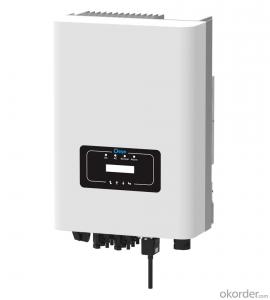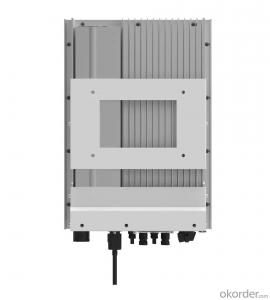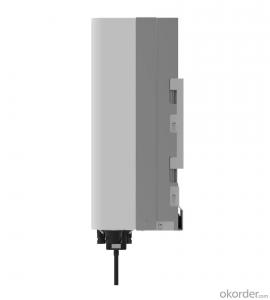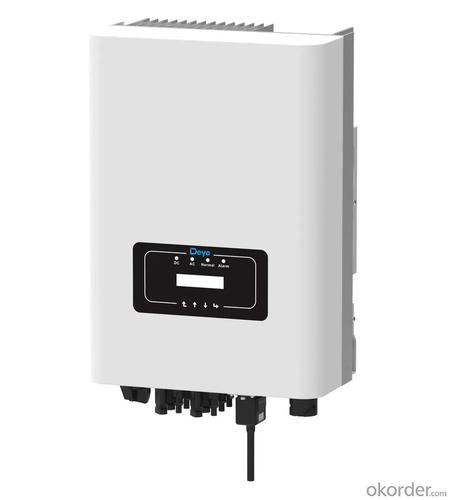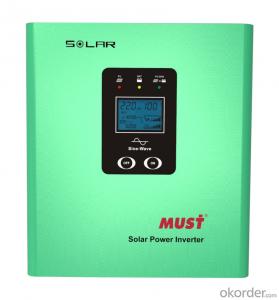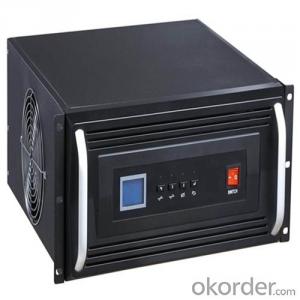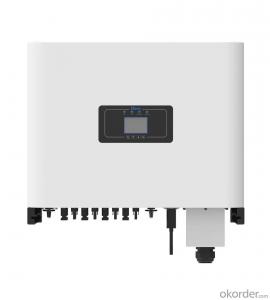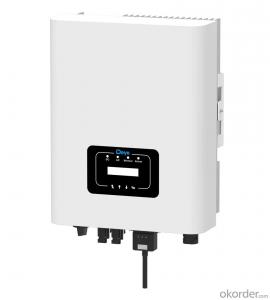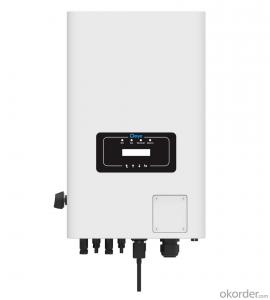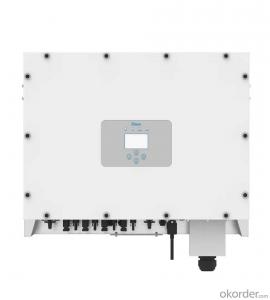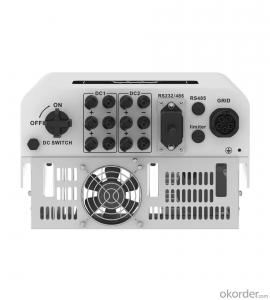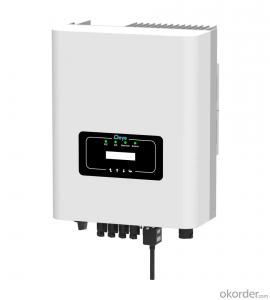Lux Solar Inverter - Sun-18/20/25k-G04 | 18-25kW | Three Phase | 2 MPPT
- Loading Port:
- Ningbo
- Payment Terms:
- TT OR LC
- Min Order Qty:
- 100 pc
- Supply Capability:
- 5000 pc/month
OKorder Service Pledge
OKorder Financial Service
You Might Also Like
Specification
| Technical Data | |||||
| Model | SUN-18K-G04 | SUN-20K-G04 | SUN-25K-G04 | ||
| Input Side | |||||
| Max. DC Input Power (kW) | 23.4 | 26 | 32.5 | ||
| Max. DC Input Voltage (V) | 1000 | ||||
| Start-up DC Input Voltage (V) | 250 | ||||
| MPPT Operating Range (V) | 200~850 | ||||
| Max. DC Input Current (A) | 32+32 | ||||
| Max. Short Circuit Current (A) | 48+48 | ||||
| Number of MPPT / Strings per MPPT | 2/2 | ||||
| Output Side | |||||
| Rated Output Power (kW) | 18 | 20 | 25 | ||
| Max. Active Power (kW) | 19.8 | 22 | 27.5 | ||
| Nominal Output Voltage / Range (V) | 3L/N/PE 380V/0.85Un-1.1Un, 400V/0.85Un-1.1Un | ||||
| Rated Grid Frequency (Hz) | 50 / 60 (Optional) | ||||
| Operating Phase | Three phase | ||||
| Rated AC Grid Output Current (A) | 26.1 | 29 | 36.2 | ||
| Max. AC Output Current (A) | 28.7 | 31.9 | 39.8 | ||
| Output Power Factor | 0.8 leading to 0.8 lagging | ||||
| Grid Current THD | <3%< span=""> | ||||
| DC Injection Current (mA) | <0.5%< span=""> | ||||
| Grid Frequency Range | 47~52 or 57~62 (Optional) | ||||
| Efficiency | |||||
| Max. Efficiency | 98.6% | ||||
| Euro Efficiency | 97.8% | ||||
| MPPT Efficiency | >99% | ||||
| Protection | |||||
| DC Reverse-Polarity Protection | Yes | ||||
| AC Short Circuit Protection | Yes | ||||
| AC Output Overcurrent Protection | Yes | ||||
| Output Overvoltage Protection | Yes | ||||
| Insulation Resistance Protection | Yes | ||||
| Ground Fault Monitoring | Yes | ||||
| Anti-islanding Protection | Yes | ||||
| Temperature Protection | Yes | ||||
| Integrated DC Switch | Yes | ||||
| Remote software upload | Yes | ||||
| Remote change of operating parameters | Yes | ||||
| Surge protection | DC Type II / AC Type II | ||||
| General Data | |||||
| Size (mm) | 330W×508H×206D | ||||
| Weight (kg) | 20.8 | ||||
| Topology | Transformerless | ||||
| Internal Consumption | <1W (Night) | ||||
| Running Temperature | -25~65℃, >45℃ derating | ||||
| Ingress Protection | IP65 | ||||
| Noise Emission (Typical) | <45 dB | ||||
| Cooling Concept | Smart cooling | ||||
| Max. Operating Altitude Without Derating | 2000m | ||||
| Warranty | 5 years | ||||
| Grid Connection Standard | CEI 0-21, VDE-AR-N 4105, NRS 097, IEC 62116, IEC 61727, G99, G98, VDE 0126-1-1, RD 1699, C10-11 | ||||
| Operating Surroundings Humidity | 0-100% | ||||
| Safety EMC / Standard | IEC/EN 61000-6-1/2/3/4, IEC/EN 62109-1, IEC/EN 62109-2 | ||||
| Features | |||||
| DC Connection | MC-4 mateable | ||||
| AC Connection | IP65 rated plug | ||||
| Display | LCD1602 | ||||
| Interface | RS485/RS232/Wifi/LAN | ||||
This new series of three-phase output inverter has wider range of 18kw, 20kw, 25kw than the original series, at the same time still got two integrated MPPTs, allowing two-array to input from different roof orientations. In addition, it allows the system to be monitored and controlled remotely.
2 MPP tracker, Max. efficiency up to 98.6%
Zero export application, VSG application
String intelligent monitoring (optional)
Wide output voltage range
Anti-PID function (Optional)
- Q: Can a solar inverter be used with a solar-powered air conditioner?
- Yes, a solar inverter can be used with a solar-powered air conditioner. A solar inverter is responsible for converting the direct current (DC) electricity generated by solar panels into alternating current (AC) electricity that can be used to power appliances. In the case of a solar-powered air conditioner, the solar inverter would be essential for converting the DC electricity generated by the solar panels into AC electricity to run the air conditioner.
- Q: How does a solar inverter handle anti-islanding protection?
- A solar inverter handles anti-islanding protection by continuously monitoring the grid's voltage and frequency. If the grid's voltage or frequency deviates from the predetermined range, indicating a potential islanding condition, the inverter quickly disconnects from the grid to prevent energy flow. This ensures the safety of utility workers and prevents damage to the electrical grid.
- Q: How does shade affect the performance of a solar inverter?
- Shade negatively impacts the performance of a solar inverter as it reduces the amount of sunlight reaching the solar panels, thereby reducing the amount of electricity generated. Inverters are designed to operate optimally under full sunlight, and when shaded, their efficiency decreases, leading to a decrease in overall energy production. Additionally, shade can cause hotspots on panels, potentially damaging the system and reducing its lifespan. To ensure maximum performance, it is important to minimize shade and ensure unobstructed sunlight for solar inverters.
- Q: Can a solar inverter be used in a ground-mounted solar system?
- Yes, a solar inverter can be used in a ground-mounted solar system. In fact, ground-mounted solar systems commonly utilize solar inverters to convert the direct current (DC) generated by the solar panels into alternating current (AC) that can be used to power homes or businesses or fed back into the electrical grid.
- Q: How does the voltage regulation affect the performance of a solar inverter?
- Voltage regulation is crucial for the optimal performance of a solar inverter. It ensures that the output voltage of the inverter remains within a specific range, typically the utility grid's voltage standards. Proper voltage regulation prevents overloading or underloading of the electrical devices connected to the inverter, safeguarding them from potential damage. Additionally, maintaining a stable output voltage enhances the efficiency and reliability of the solar inverter, allowing it to deliver consistent power to the connected load and maximize the overall system performance.
- Q: Are solar inverters compatible with battery storage systems?
- Yes, solar inverters are compatible with battery storage systems. In fact, solar inverters play a crucial role in integrating battery storage with solar power systems. Solar inverters convert the direct current (DC) electricity generated by the solar panels into alternating current (AC) electricity that can be used to power our homes and businesses. Battery storage systems, on the other hand, store excess solar energy for later use, allowing us to use solar power even when the sun is not shining. When combined with solar inverters, battery storage systems can be charged using the excess energy generated by the solar panels during the day, and then discharge that stored energy during the night or during periods of high energy demand. To facilitate compatibility, solar inverters used in battery storage systems are equipped with additional features and functionalities. For example, they may have built-in charge controllers that regulate the charging and discharging of the batteries, ensuring their optimal performance and longevity. Additionally, advanced inverters may also include smart grid capabilities, allowing them to communicate with the utility grid and optimize energy flows based on grid conditions and electricity prices. Overall, solar inverters are essential components in ensuring the seamless integration of battery storage systems with solar power, enabling us to maximize the benefits of clean and sustainable energy.
- Q: Can a solar inverter be used in a mobile or portable solar power system?
- Yes, a solar inverter can be used in a mobile or portable solar power system. The inverter converts the direct current (DC) generated by the solar panels into alternating current (AC), which is required to power most electronic devices. By incorporating a solar inverter, the mobile or portable solar power system can provide AC power for various applications, such as charging electronic devices or running small appliances, making it a versatile and convenient solution for powering devices on the go.
- Q: How does a solar inverter handle shade on solar panels?
- A solar inverter handles shade on solar panels by utilizing a technology called maximum power point tracking (MPPT). MPPT allows the inverter to constantly monitor the output of each individual solar panel and adjust the voltage and current to maximize the power production. When shade is detected on a solar panel, the inverter automatically reduces the power output of the affected panel, ensuring that the shaded area does not significantly impact the overall performance of the system.
- Q: What is the role of a fault detection feature in a solar inverter?
- The role of a fault detection feature in a solar inverter is to monitor and identify any malfunctions or abnormalities within the system. It is responsible for detecting faults such as overvoltage, under-voltage, over-temperature, short circuits, ground faults, or any other potential issues that may arise. This feature helps ensure the safe and efficient operation of the solar inverter by promptly alerting the user or system operator about the fault, allowing for quick troubleshooting and maintenance.
- Q: What is the role of a solar inverter in preventing overloading?
- The role of a solar inverter in preventing overloading is to regulate the flow of electricity from the solar panels to the electrical grid or battery system. It ensures that the amount of power being generated by the solar panels does not exceed the capacity of the grid or battery, thus preventing overloading and potential damage to the system.
Send your message to us
Lux Solar Inverter - Sun-18/20/25k-G04 | 18-25kW | Three Phase | 2 MPPT
- Loading Port:
- Ningbo
- Payment Terms:
- TT OR LC
- Min Order Qty:
- 100 pc
- Supply Capability:
- 5000 pc/month
OKorder Service Pledge
OKorder Financial Service
Similar products
Hot products
Hot Searches
Related keywords
